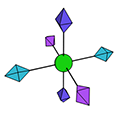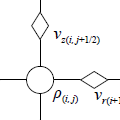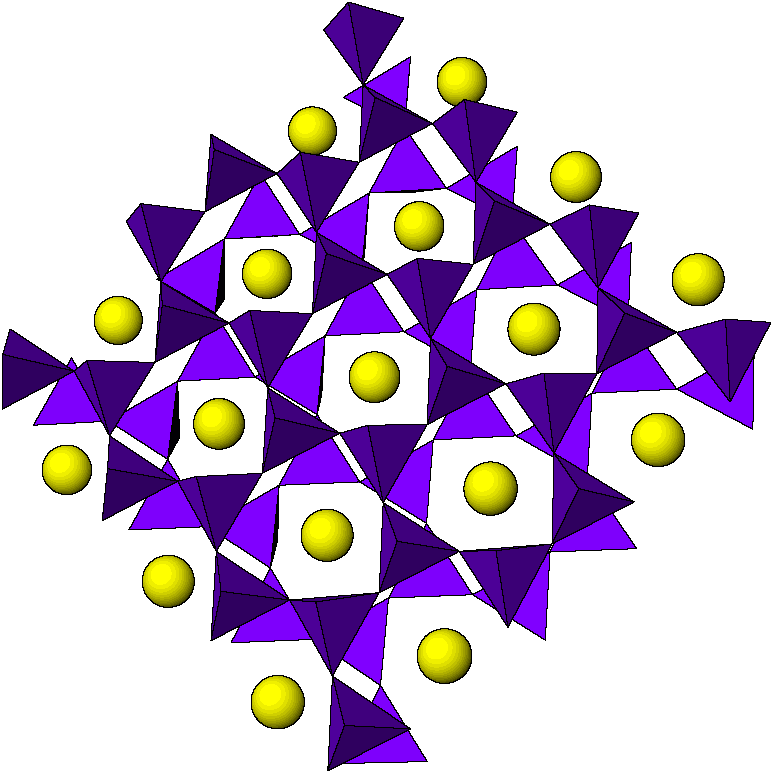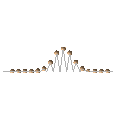Numerical methods for wave propagation
Many wave phenomena can be predicted by means of numerical methods. Here, I summarize the implemented computational methods for simulation of small amplitude acoustic waves, nonlinear acoustic waves, elastic waves and lattice dynamics.
Most of the codes presented here are developed on a variety of coordinate systems as cartesian 1D, 2D and 3D; and curvilinear coordinate systems as polar, cylindrical axisymmetric, cylindrical and spherical coordinate systems. The implementation of the codes is mainly based on finite differences in time domain (FDTD), but also pseudo-spectral time domain methods (PSTD) are employed in order to accurately solve the partial differential operators.
Acoustic numerical computations
Linear acoustics: fluids

Linear acoustics FDTD methods are useful for characterize the radiation of sound sources and also to study the scattering of sound waves by medium sized structures. Thus, arbitrary source conditions can be implemented on an arbitrary boundary conditions, and the acoustic fields can be explored and measured over the entire domain, leading to huge possibilities in the analysis and design of the acoustics systems.
Linear acoustics: biological media
When considering ultrasound waves travelling through complex heterogeneous biological media, tissue attenuation response must be taken into account. Typical attenuation for the frequency range typical in medical ultrasound applications follows a frequency power law \(\alpha (f)=\alpha _0 f^{\gamma}\), where the exponent is in the range \(\gamma(1, 2)\). Including this behavior in time domain models could be a cumbersome task, however, if a multiple relaxation media is modeled a frequency power law can be achieved by a FDTD algorithm without including convolution operators.
Nonlinear acoustics: fluids

Accurate predictions of acoustic fields are fundamental in the developing of new ultrasound techniques for medical applications. Estimations of focused ultrasound fields for therapy and imaging requires to take into account a wide range of linear acoustics phenomena, but also in many practical applications the nonlinear processes cannot be neglected. Thus, the numerical solution of many ultrasound techniques are required in order to characterize nonlinear effects and obtain accurate predictions of acoustic fields.
Nonlinear acoustics in relaxing media

Many complex media exhibit acoustic dispersion and attenuation associated to relaxation processes. The relaxation of the molecules of oxygen and nitrogen in air, or the relaxation behavior observed in sea water are the most common examples. If a monochromatic wave is considered, this attenuation / dispersion can be included time domain models by adding losses over a slightly sound speed shifted media. However, when high amplitude waves travel, the nonlinear effects generates a cascade of harmonics, and each attenuates with different magnitude.
Nonlinear acoustics including frequency power law for soft-tissue simulation

Typical attenuation in the frequency range for medical ultrasound applications follows a frequency power law \(\alpha (f)=\alpha _0 f^{\gamma}\), where the exponent is in the range \(\gamma(1, 2)\). When high amplitude waves travel through tissue, the nonlinear effects generates a cascade of harmonics, and each attenuates according the above power law. Including this behavior directly in time domain is a complex task. The code developed accounts for this effect by means of a sum of relaxation processes, avoiding computational-expensive convolutional operators.
Elastodynamics numerical computations
Linear elastodynamics: solid media

If shear elasticity is included, transversal waves can propagate through the media. Thus, elasticity of solid media, leads to a variety of wave phenomena that can be modeled by numerical methods: shear wave propagation, surface wave predictions for SAW devices or geosciences, modes in elastic plates, or design new metamaterials are only few examples of the potential of numerical methods for elastodynamics.
Linear elastodynamics: vegetal tissue propagation

The complex propagation of vegetable tissue for ultrasound quality evaluation can be modeled by means of elastodynamics numerical methods. Experimental observations of superficial waves travelling through the shell of the fruit serves as the basis for the numerical simulation data. Thus, superficial wave devices for orange fruit acoustic characterization has been constructed and provides indirect measurements of fruit dehydration state.
Linear elastodynamics: anisotropic attenuation/dispersion models for bone

Bones are complex media: a porous solid structure filled by soft-tissue like and viscous fluids. Ultrasound waves travelling through bone presents high attenuations (~50 Np/m @ 0.5 MHz) with non-squared frequency dependence. Wave dispersion is significant factor in bone propagation too. But the most difficult goal to achieve on bone modelling and numerical methods is the anisotropy: elasticity, attenuation and dispersion presents different values depending on the propagation direction. The model developed includes all the above effects in a time-domain formulation without including computational operators.
Coulomb lattices computations
Coulomb linear chain

One of the most simple repulsive lattice is the one dimensional Coulomb chain. However, despite its simplicity, its dynamics is very rich: phonon propagation to nonlinear travelling localized structures, etc.. In this line I'm investigate travelling lattice kinks, with the application in characterization and modelling one dimensional nonlinear travelling excitations (or quodons after M. Russell works) in layered media as mica muscovite.
Chain of magnets

In order to demonstrate the ability of layered media to propagate nonlinear travelling one-dimensional excitation (quodons), experimental macroscopic modelling of the Coulomb chain by a chain of coupled magnet. These experiments are reproduced in numerical simulations o a chain of magnetically coupled pendulums, where kinks and nonlinear harmonic waves have been observed and measured.
Mechanical computations
Coupled pendulum chain

Pendulum is the most simple nonlinear oscillator. However, despite its simplicity, a wide range of nonlinear phenomena can be studied and modeled. Furthermore, if a chain of coupled pendula is considered, phonons can propagate through the lattice, and due to the existence of nonlinearities and dispersion, exotic wave phenomena can be observed. Here I study breathers, kink, intrinsic localized modes and chaotic behavior of the chain.
Ring of coupled pendula

By simply changing the boundary conditions of the chain, linking the last and the first pendulum, a ring can be formed. Moreover, under parametric excitation, the rich dynamics observed presents many analogies with the behavior of bubbles under the action of an external pressure field. Thus, the computational developed codes allows us to explore complex dynamics of discrete lattices, and extrapolate results to design new microbubble applications.
2-Dimensional coupled oscillators

If a surface of coupled oscillators is taken into account, vibration patterns can be observed both, in flat surfaces or in warped surfaces (i.e. spherical shape modes). This numerical codes allows to investigate the behavior of complicated systems like Ultrasound Contrast Agents or drops under the action of an ultrasonic field.